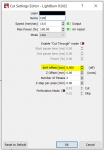Leo Voisine
Member
- Messages
- 5,730
- Location
- East Freeetown, Massachusetts
I will be asking this same question on the RDWorks forum
One thing I have noticed on laser cutting my thin - solid hardwood is that it breaks EXTREMELY easily.
The laser beam cuts with a draft angle, and depending on the style of lense used and the focal distance, the draft angle can change. At least that is how I see it.
I am using a 38.1 mm lense which has a very short focal length to it. A 63.5 mm lense has a much longer focal length, which MAY make less of a draft angle.
Now, I am cutting solid hardwood at .150 - .165 thick with a TINY cross section due to the size of the text. The laser cuts ON the line and I see no option to change that. The result is that the text gets thinner at the top with a fine cut through line at the bottom. Additionally, the grain of the solid wood it very weak depending on the direction of grain at those narrow cross section. Thusly - really weak sections.
I think trying a longer focal length lense
I think plywood will be a better choice over solid thin wood because of alternating grain directions.
I may be able to stain 1/8 baltic birch before laser cutting.
This brings me back to finding thin plywood.
What are your thoughts
One thing I have noticed on laser cutting my thin - solid hardwood is that it breaks EXTREMELY easily.
The laser beam cuts with a draft angle, and depending on the style of lense used and the focal distance, the draft angle can change. At least that is how I see it.
I am using a 38.1 mm lense which has a very short focal length to it. A 63.5 mm lense has a much longer focal length, which MAY make less of a draft angle.
Now, I am cutting solid hardwood at .150 - .165 thick with a TINY cross section due to the size of the text. The laser cuts ON the line and I see no option to change that. The result is that the text gets thinner at the top with a fine cut through line at the bottom. Additionally, the grain of the solid wood it very weak depending on the direction of grain at those narrow cross section. Thusly - really weak sections.
I think trying a longer focal length lense
I think plywood will be a better choice over solid thin wood because of alternating grain directions.
I may be able to stain 1/8 baltic birch before laser cutting.
This brings me back to finding thin plywood.
What are your thoughts

